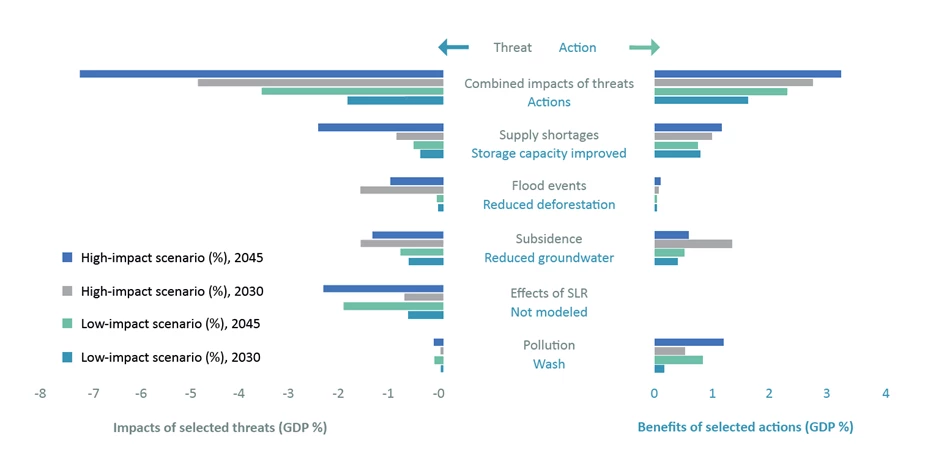 Rooftop solar in India
Rooftop solar in India
(This post also appears on the Getting Infrastructure Finance Right blog.)
Sunlight is the fastest-growing source of renewable energy that can be captured for large-scale power generation . In the past decade, solar photovoltaic (PV) technology and solar PV plants have grown ten-fold, bringing solar PV capacity up to 500 GW compared to only 22 GW in 2009. And global cumulative concentrated solar power (CSP) installed capacity grew from 0.8 GW to slightly 5 GW over the same period.
Given the urgent call to accelerate a global energy transition, to which a mature global solar market can greatly contribute, we saw a real need to shed more light on the different kinds of public interventions that have been successful in mobilizing commercial financing for utility-scale solar projects.
After undertaking a comprehensive assessment across seven developing countries—Chile, India, Maldives, Morocco, the Philippines, Senegal, and South Africa—we arrived at the following five key takeaways:
- Countries that have predictable policies and offer long-term visibility build market confidence. For example in India, following the liberalization of the power market in the 2000s, the central government announced the National Solar Mission that set a very ambitious goal of 100 GW of solar power by 2022 . By setting up numerous government and state entities to help bolster the solar market, resolving congestion issues, and mitigating off-taker risks, India sent a strong signal to investors about their commitment to harnessing the country’s significant solar potential. They have since become a global leader in solar power.
- Reforms that create strong regulatory and legal frameworks and financially sustainable power utilities are essential. While solar deployment can be supported by credit enhancement mechanisms such as guarantees in the short-to-medium term, over the long term, reforms are needed to avoid the recurrent need for state guarantees and similar instruments that impact national budgets. In Chile, a fully unbundled and liberalized electricity sector that is grounded in privatization reforms that took place more than 30 years ago has fostered a vibrant renewables sector over the past decade . Their established regulatory framework and the presence of strong off-takers have been key to the rapid scale-up of solar investment in the country. Coupled with their commitment to decarbonization, Chile is credited to be the most attractive emerging market for clean energy investment.
- Countries must build the capacity of key institutional stakeholders to face challenges associated with the scale-up of solar power. This means ensuring that institutional stakeholders stay abreast of the development of solar technologies and their applications to design fit-for-purpose responses to maximize the value added and attract commercial interest. In South Africa for example, a well-designed competitive procurement process was instrumental in unlocking the commercial grid-connected solar market and opened the door for participation by international developers. An efficient bidding process and high-quality contractual documents, which reflected a deep understanding of the private sector’s perspective, helped ensure a high response rate to the tenders.
- A lack of investment in grid infrastructure can limit solar development. Grid integration and variable renewable energy dispatch capability are important considerations for commercial investors regardless of the market size. Although Senegal has achieved remarkable success in attracting commercial finance for grid-connected solar, the capacity of their grid to absorb variable power remains the key limitation to further significant solar developments. In relatively small and weakly interconnected power markets, grid absorption capacity can become an issue as soon as solar plants are commissioned.
- One Size Does Not Fit All. Looking across the countries we analysed, we realized that there is no one-size-fits-all approach to financing solar energy projects . For example, we saw that Morocco used a substantial amount of concessional financing starting in the early 2010s to establish itself as a world’s leader in CSP technology, while Chile developed its solar market PV without public concessional financing—achieving record-low prices. Around the same time, South Africa invited private investment through public auctions, while the Philippines determined that a feed-in tariff policy was the best course of action.
What do commercial investors need most?
Let’s now look at this from the investors’ side. According to a survey of private investors that we conducted for the report, the most important investment driver is the ability of a public off-taker to pay for the power it purchases. After that, we see the importance of clear rules governing private investment and regulatory aspects—in addition to technical and operational considerations such as power evacuation and grid connection.

Our hope is that these takeaways and new evidence brought forth in our report “The Role of the Public Sector in Mobilizing Commercial Finance for Grid-Connected Solar Projects” can inform policy makers’ decisions regarding the allocation of public financing. We also hope that it provides new and practical perspectives for development partners that are working to attract non-public sources of financing in support of the sustainable solar energy agenda.

Subscribe here to stay up to date with the latest Energy blogs.



Join the Conversation